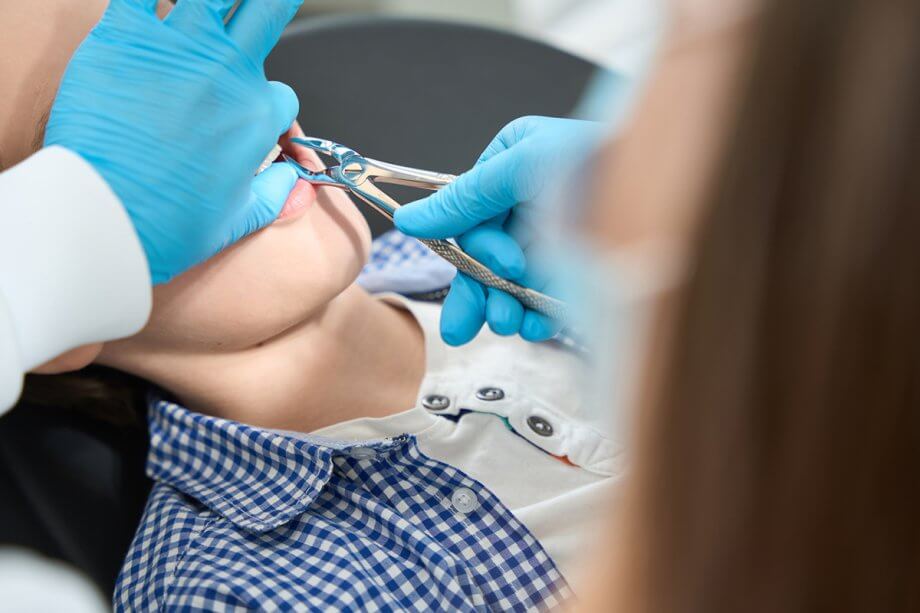A tooth extraction is a standard dental procedure recommended when a natural tooth sustains damage and cannot undergo restoration with a filling, crown, or root canal.
Benefits of Tooth Extraction
Protect Oral Health
If you have a damaged or infected tooth, your oral health may be at risk. A tooth infection (abscess) can spread to neighboring teeth and also enter the bloodstream, endangering your overall health.
Improve Chewing
Chewing on a broken or decayed tooth can be uncomfortable. The longer you chew on a damaged tooth, the more likely it is to break. It is best to have the tooth promptly extracted.
Improve Self-Image
A broken or decayed tooth can affect self-image. Pulling the tooth to make way for a replacement improves confidence.
Allow Permanent Replacement
When your damaged tooth is out of the way, you can opt for a replacement like a bridge, implant, or partial denture to restore your healthy-looking smile.
The Tooth Extraction Procedure
Tooth extraction is a gentle, standard procedure that a dentist can perform in the office. Some patients worry about extractions, but dentists reassure them that the procedure is less uncomfortable than they might expect.
Step 1: Anesthesia
For a simple extraction of a non-impacted tooth, local anesthesia is generally all that a patient needs to feel comfortable. The doctor applies this anesthesia with care to minimize any issues.
Step 2: Loosening the Tooth
Using a dental tool called an elevator, the doctor gently rocks the tooth back and forth in the socket. The gentle rocking motion gradually loosens the tooth from the socket.
Step 3: Removing the Tooth
When the tooth separates from the socket, the dentist removes it using forceps.
Step 4: Securing the Gum (If Necessary)
Sometimes, extraction sites require sutures to heal appropriately. Dentists often use dissolvable sutures, so you will not have to return to have them removed.
What Happens After a Tooth Extraction
Following is a timeline of what to expect after your tooth extraction procedure:
The First 24 Hours
Bleeding from the extraction site should gradually cease. If bleeding continues past the 24-hour mark, consult your dentist. A beneficial blood clot will form in the empty socket. Take care not to disturb this clot by not spitting, rinsing, smoking, or using a straw.
You may experience inflammation and swelling around the extraction site. Gum tenderness is common. You may have swelling and minor bruising on your cheek and jaw. Use cold compresses on the outside of your cheek to control inflammation and discomfort.
For the first day or two, consume a liquid diet, gradually adding soft foods like mashed potatoes, blended soups, and smoothies. Do not consume hot foods or drinks at this time.
First 1-2 Weeks
The gums will begin to seal off the socket, and new gum tissue will form. For your comfort and continued healing, continue to avoid crunchy, spicy, sharp, or hard foods.
3-4 Weeks Post-Extraction
After 3-4 weeks, your socket should contain new gum tissue, and most discomfort should have resolved itself. The jawbone itself heals more slowly than the gum tissue.
Replacing Your Extracted Tooth
After your gums and jawbone heal, you can receive a tooth replacement. Flippers, partial dentures, dental implants, and bridges can replace the missing tooth and complete your smile.
Many patients feel that they can live with a gap in their smile, but the consequences of not replacing a tooth are more significant than they realize. Teeth may shift, causing misalignment and a greater risk of gum disease and tooth decay. Food and bacteria may collect in the space between teeth and damage oral health. Dental bite can shift, causing increased wear on teeth and increasing the risk of tooth breakage.
Frequently Asked Questions About Tooth Extractions
When will a dentist decide to extract a tooth?
Dentists often recommend extractions in these situations:
- Overcrowding
- To make way for orthodontic work
- Excessive decay
- Bone loss under the tooth attributed to gum disease
How can I prevent the need for tooth extractions?
Take good care of your teeth and gums. If you have a small cavity or toothache, call your dentist right away for treatment. Repairing a small problem is much easier and less costly than extracting and replacing a tooth.
Contact Dental Associates, LLP
Tooth extractions are faster and more comfortable than patients might expect. If you believe your tooth needs extraction, we can help you determine the need for the procedure. Contact our Farmington, CT, office to schedule your appointment today.

